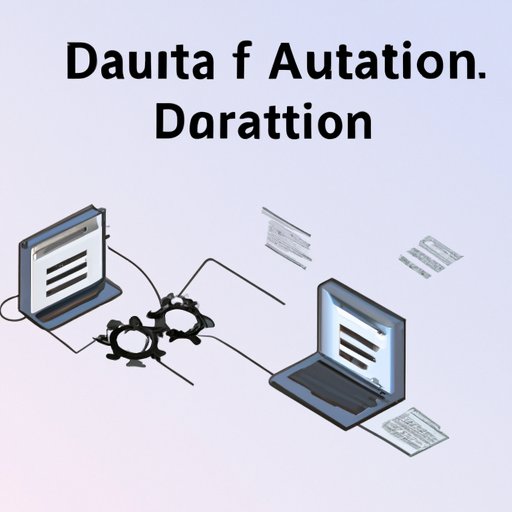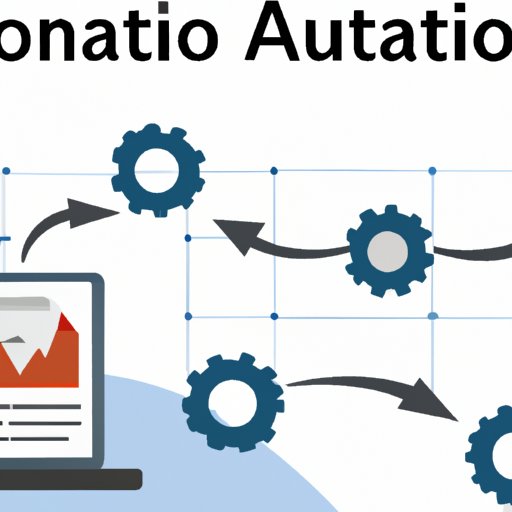Introduction
Data automation has become a valuable tool for businesses of all sizes to increase efficiency and productivity. But what exactly is data automation? In essence, data automation is the process of collecting, organizing and managing data with automated tools and processes. It allows businesses to store, manage and analyze data quickly and accurately, making it easier to make informed decisions and improve operations.

An Introduction to Data Automation and its Uses
Data automation involves the use of software or hardware tools to automate processes related to the collection, storage, management and analysis of data. This type of automation can help streamline many different tasks, from customer relationship management (CRM) to inventory management. There are several different types of data automation, including web-based automation, cloud-based automation, and application programming interface (API) automation.
Data automation can be used in a variety of ways in businesses. For example, it can help save time by automating tedious and repetitive tasks such as data entry. It can also help ensure accuracy by eliminating human errors and reducing manual input. Additionally, data automation can be used to improve customer service by providing real-time insights into customer needs and preferences.
Understanding the Basics of Data Automation
To understand the basics of data automation, it’s important to know what is involved. Generally speaking, data automation requires three main components: a data source, an automation tool, and an action. A data source is the source of information that will be used for the automation process. The automation tool is the software or hardware that will be used to automate the process. Finally, an action is the task that will be performed on the data.
In terms of how data automation works, it typically involves the following steps: first, data is collected from the source; second, the data is organized and managed using the automation tool; third, the data is analyzed to identify patterns and trends; and finally, actions are taken based on the analysis. This process helps to streamline data management, allowing businesses to make faster and more informed decisions.

How to Implement Data Automation in Your Organization
Implementing data automation in an organization can be a complex process, but it can be done successfully with the right planning and preparation. Here are some tips for implementing data automation in your organization:
- Identify your needs: First, it’s important to identify your organization’s specific needs when it comes to data automation. What tasks do you need to automate? What data sources will you need? Answering these questions will help you determine the best approach for your organization.
- Choose the right tools: Once you have identified your needs, it’s time to choose the right tools for the job. There are a wide range of data automation tools available, so it’s important to choose one that meets your organization’s specific requirements.
- Define your processes: After choosing the right tools, it’s important to define your processes. This includes setting up security protocols, defining data access rules, and creating an audit trail. This will help ensure that your data is secure and compliant with regulations.
- Set up security protocols: As with any technology, data automation should be accompanied by comprehensive security protocols. This includes ensuring that only authorized users have access to the data, encrypting stored data, and monitoring access logs.

Common Challenges of Data Automation and How to Overcome Them
Data automation can bring many benefits to an organization, but it’s not without its challenges. Here are some of the most common challenges of data automation and how to overcome them:
- Cost of implementation: The cost of implementing data automation can be a major challenge for organizations. To reduce costs, organizations should look for ways to optimize their existing systems and processes, rather than investing in new tools and technologies.
- Human error: Despite the advantages of data automation, there is still the potential for human error. Organizations should invest in training and education to help employees understand the importance of data accuracy and security.
- Integration issues: Data automation tools must be able to integrate with existing systems and processes. To avoid integration issues, organizations should thoroughly test new tools before implementing them.
- Maintenance requirements: Maintaining data automation tools can be time-consuming and expensive. To reduce maintenance requirements, organizations should look for tools that require minimal upkeep.
Conclusion
Data automation is an invaluable tool for organizations of all sizes. It can help streamline processes, improve accuracy and increase productivity. However, it is important to understand the basics of data automation, as well as the potential challenges. By following the tips outlined above, organizations can successfully implement data automation and reap the rewards.
(Note: Is this article not meeting your expectations? Do you have knowledge or insights to share? Unlock new opportunities and expand your reach by joining our authors team. Click Registration to join us and share your expertise with our readers.)
